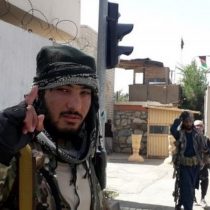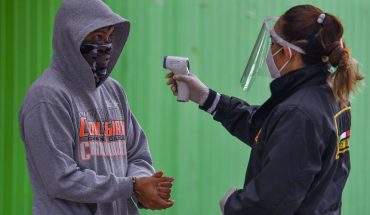
The United States and its NATO allies have spent most of the past 20 years training and equipping Afghan security forces.
Countless American and British generals said over and over again that they created a powerful and capable Afghan army. Promises that today seem quite empty.
Who has more soldiers?
The Afghan government should continue to have the upper hand. Its military power is, in theory, greater.
The Afghan security forces have, at least on paper, more than 300,000 members. This includes the Afghan army, air force and police.
However Afghanistan has always struggled to meet its military recruitment goals.
The Afghan army and police have a troubled record of casualties, desertions, and corruption, with some unscrupulous commanders claiming salaries from soldiers who do not exist – the so-called “ghost soldiers.”
In his latest report to the U.S. Congress, the Special Inspector General for Afghanistan expressed “grave concern about the corrosive effects of corruption… and the dubious accuracy of the data on the actual strength of the force.”
Jack Watling, of the Royal United Services Institute (RUSI), claims that not even the Afghan army knows, nor has it ever known, how many troops it has.
In addition, Watling says there have been problems with the maintenance of military equipment and troop morale.
Soldiers are often sent to areas where they have no cultural or family connections, one of the reasons why some may rush to leave their posts even without fighting.
The Fight for Control of Afghanistan
How the Taliban occupied most districts and provincial capitals
Source: BBC research. The boundaries of the districts are those defined by the government in 2005.
The Taliban’s military might is even harder to measure.
According to the U.S. Counterterrorism Center, estimates suggest a core of 60,000 fighters. If other militia and partisan groups are added together, that number could exceed 200,000.
But Mike Martin, a former Pashto-speaking British army officer who has followed the history of the conflict, warns of the dangers of defining the Taliban as a single monolithic group.
Instead, it states that “the Taliban are closer to a coalition of independent franchisees, loosely affiliated, and most likely temporarily, to each other.”
Martin points out that the Afghan government itself is torn apart by the ups and downs of local factions, which change from one side to the other frequently.
Afghanistan’s changing history illustrates how families, tribes, and even government officials have been switching sides, in part to ensure their own survival.
What about weapons?
Regardless of the number of soldiers, in terms of the arsenal that each army possesses, once again, the Afghan government should have an advantage in terms of both funding and weapons.
The official military has received billions of dollars to pay for soldiers’ salaries and equipment, mostly from the United States.
In his July 2021 report, the U.S. inspector in Afghanistan stated that more than US$88,000 million in security.
But he added almost as an omen: “The question of whether that money has been well spent will ultimately be answered by the outcome of the fighting on the ground.“.
The Afghan Air Force should give it a critical advantage on the battlefield, but it has always struggled to maintain and fly its 211 aircraft (a problem compounded by deliberate Taliban attacks on pilots).
Nor is the army capable of meeting the demands of commanders on the ground.
Hence U.S. air support in cities like Lashkar Gah in the face of the Taliban attack. It is unclear how much longer the United States will continue to provide that support.
Afghanistan has been awash with weapons since the Soviet invasion in the ’80s, and the Taliban have shown that even the most rustic artillery can defeat sophisticated Western commandos.
Consider the deadly effect of improvised explosive devices (known as IEDs) on U.S. and British forces. That, and local knowledge and understanding of the terrain, are a crucial advantage.
An unprecedented strategy vs. an indecipherable strategy
Despite the nature of theesordenada of the Taliban, some see signs of a coordinated plan in its recent mission.
Ben Barry, a former British Army brigadier and current fellow of the Institute for Strategic Studies, a think tank, acknowledges that Taliban advances may be opportunistic, but adds that “it would have been difficult to design a better plan What this“.
The expert points out that the taliban attacks focused on the north and west, and not on their traditional southern strongholds, and that the regional capitals have fallen into their hands. sometimes without resistance.
The Taliban have also captured key border crossings and checkpoints, diverting much-needed customs revenues from a cash-stray government.
Targeted killings of key officials, human rights activists and journalists have also intensified. And slowly but inexorably they are killing out some of the small gains made over the past 20 years.
The Afghan government’s strategy, on the other hand, is more difficult to define.
Promises to regain all the territory captured by the Taliban are ringing hollower and louder.
The Taliban too seem to be winning the propaganda war and the narrative battle.
Barry states that their drive on the battlefield has raised morale and given them a sense of unity.
On the contrary, the Afghan government has been on the defensive, arguing and firing the generals.
How does this end?
The situation certainly looks bleak for the Afghan government.
However Jack Watling, of RUSI, says that although the outlook is increasingly pessimistic for the Afghan military, “the situation could still be saved through politics.”
If the government can win over the leaders of the country’s tribal groups, he says, there is still the possibility of a peaceful transition.
Mike Martin agrees, noting that several leaders have already reached major cities, and are already closing deals.
The fighting season may end when winter arrives, which will make it difficult for forces to maneuver on the ground.
But for the time being it seems that america’s and NATO’s efforts to bring peace, security, and stability to Afghanistan have been as futile as those of the Soviets before them.





